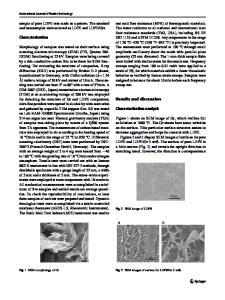Mechanical Properties of Ultralow Density Graphene Oxide/Polydimethylsiloxane Foams
- PDF / 1,163,149 Bytes
- 6 Pages / 432 x 648 pts Page_size
- 14 Downloads / 462 Views
Mechanical Properties of Ultralow Density Graphene Oxide/Polydimethylsiloxane Foams Cristiano F. Woellner1,2, Peter S. Owuor3, Tong Li2, Soumya Vinod3, Sehmus Ozden2, Suppanat Kosolwattana3, Sanjit Bhowmick5, Luong X. Duy3, Rodrigo V. Salvatierra3, Bingqing Wei4, Syed A. S. Amanulla5, James M. Tour3, Robert Vajtai3, Jun Lou3, Douglas S. Galvão1,2, Chandra S. Tiwary3, Pulickel. M. Ajayan3 1
Applied Physics Department, State University of Campinas, 13083-859 Campinas-SP, Brazil
2
Center for Computational Engineering & Sciences, State University of Campinas, Campinas-SP, Brazil
3
Department of MSNE Rice University Houston, TX 77005, USA
4
Mechanical Engineering University of Delaware DE 19717, USA,
5
Hysitron, Inc. Minneapolis, MN 55344, USA
ABSTRACT
Low-density, highly porous graphene/graphene oxide (GO) based-foams have shown high performance in energy absorption applications, even under high compressive deformations. In general, foams are very effective as energy dissipative materials and have been widely used in many areas such as automotive, aerospace and biomedical industries. In the case of graphene-based foams, the good mechanical properties are mainly attributed to the intrinsic graphene and/or GO electronic and mechanical properties. Despite the attractive physical properties of graphene/GO based-foams, their structural and thermal stabilities are still a problem for some applications. For instance, they are easily degraded when placed in flowing solutions, either by the collapsing of their layers or just by structural disintegration into small pieces. Recently, a new and scalable synthetic approach to produce low-density 3D macroscopic GO structure interconnected with polydimethylsiloxane (PDMS) polymeric chains (pGO) was proposed. A controlled amount of PDMS is infused into the freeze-dried foam resulting into a very rigid structure with improved mechanical properties, such as tensile plasticity and toughness. The PDMS wets the graphene oxide sheets and acts like a glue bonding PDMS and GO sheets. In order to obtain further insights on mechanisms behind the enhanced mechanical pGO response we carried out fully atomistic molecular dynamics (MD) simulations. Based on MD results, we build up a structural model that can explain the experimentally observed mechanical behavior.
Downloaded from https://www.cambridge.org/core. Cornell University Library, on 19 Jan 2018 at 14:41:55, subject to the Cambridge Core terms of use, available at https://www.cambridge.org/core/terms. https://doi.org/10.1557/adv.2018.49
INTRODUCTION Low-density porous foam materials based on graphene/graphene oxide (GO) structures are very promising to energy absorption applications, even under high compressive deformations [1-4]. Structural foams are widely used in packing industry to cushion delicate products and also as weight saving materials. Other areas have also benefited from these 3D foams, such as biomedical [5], fuel cells [6], supercapacitors [7], flexible electronics [8-9], among others. The recently proposed freez
Data Loading...











